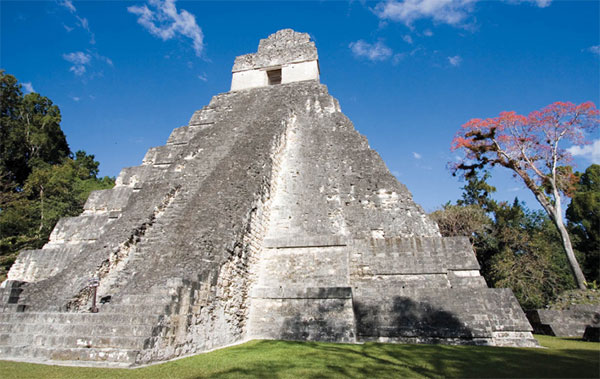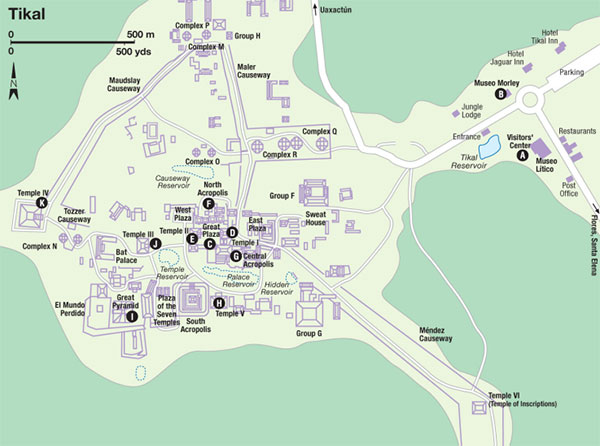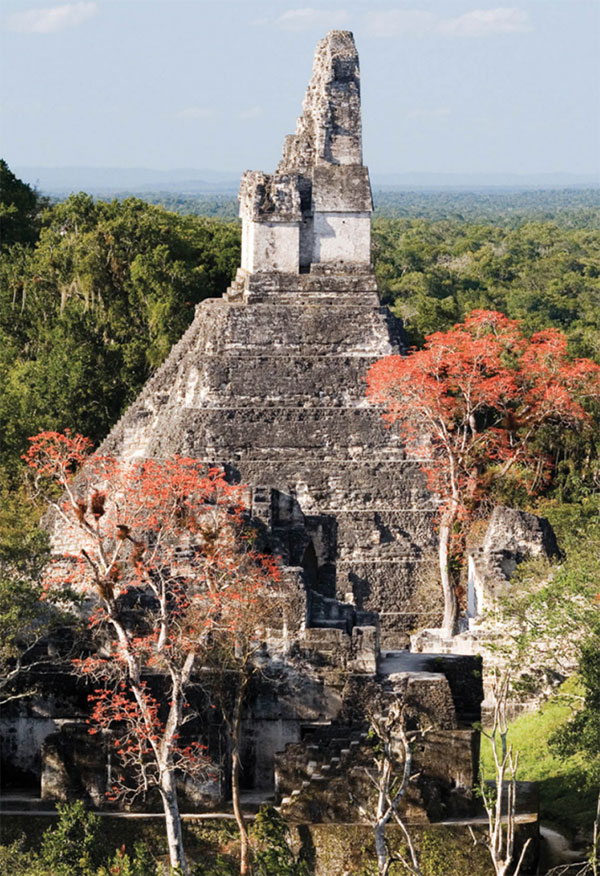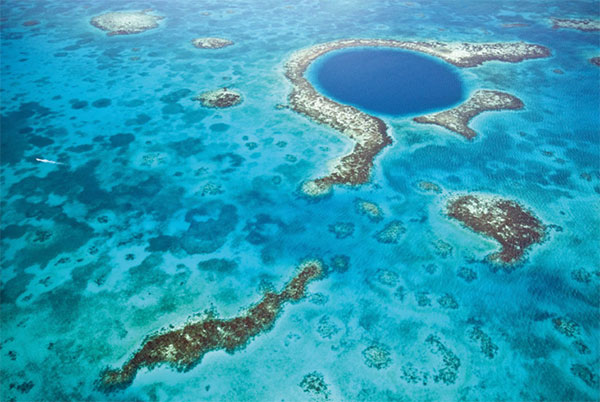WILDLIFE IN THE PETÉN
Despite illegal logging and environmental damage, vast areas of the Petén forest remain intact, and this is still one of the best places in Central America to see some spectacular wildlife. A number of national parks and preserves have been established (and combined as the Maya Biosphere Reserve) to protect the subtropical habitat of over 4,000 plant species and animals that include jaguars, crocodiles, tapirs, ocelots, collared peccaries, armadillos, boa constrictors, blue morpho butterflies, and 450 resident and migratory birds. Even if you only make it to Tikal, you should hear the deafening roar of the howler monkey, glimpse toucans and parrots squabbling in the forest canopy, and perhaps spot an ocellated turkey or a gray fox in the undergrowth.
Tikal’s renaissance was sparked by Ah Cacau or Lord Chocolate (682–734) and continued by his son Caan Chac, who ordered the construction of most of the temples that bestride the ruins today, which are taller and grander than earlier buildings. Caan Chac also reassumed control of the core Maya area, eclipsing bitter rival Calakmul. Tikal continued to control the region, enjoying unsurpassed stability and prosperity into the 9th century; it faded quickly by AD 900, however, along with all the other lowland sites.
Visiting Tikal
As well as the standard visiting hours, special tickets are also available for sunrise (from 4am) and evening (between 6–8pm) visits. Before (or after) you enter Tikal (www.tikalnationalpark.org/Tikal-Temples.html; daily 6am–6pm), have a look in the Visitors’ Center A [map] , where the Museo Lítico has an excellent collection of stelae and carvings; nearby is the Museo Morley B [map] , where the exhibits include ceramics, jade, the burial ornaments of Lord Chocolate, and Stela 29, the oldest found at Tikal (both daily).

Temple I at Tikal.
Corrie Wingate/Apa Publications
The Great Plaza C [map] is the first place to head for, the nerve center of the city for 1,500 years. The grassy plaza is framed by the perfectly proportioned Temples I and II to the east and west, the North Acropolis, and the Central Acropolis to the south. In Classic Maya days, these monumental limestone buildings would have been painted vivid colors, predominantly red, with clouds of incense smoke smoldering from the upper platforms. Civic and religious ceremonies, frequently including human sacrifice, would have been directed by priests and kings from the top of the temples.
Temple I D [map] (also known as the Temple of the Giant Jaguar because of a jaguar carved in its door lintel), was built to honor Lord Chocolate, who was buried in a tomb beneath the 44-meter (144ft) high structure with a stately collection of goods (now exhibited in the Morley Museum). Facing Temple I across the plaza is Temple II E [map] (also known as the Temple of the Masks), slightly smaller at 38 meters (125ft) tall, and a little less visually impressive, too, because part of its massive roof comb is missing. Both temples were constructed around AD 740.
Between the two mighty edifices, on the north side of the plaza is a twin row of stelae and altars, about 60 in all. Many date from Classic Maya times, but were moved here from other parts of the site by post-Classic people in a revivalist effort – Stela 5 has some particularly fine glyphs. Behind the stelae is the untidy bulk of the North Acropolis F [map] , a jumble of disparate masonry composed of some 16 temples and an estimated 100 buildings buried underneath, parts of which are some of the oldest constructions at Tikal, dating back to 250 BC.
On the south side of the plaza is the Central Acropolis G [map] , a maze of buildings thought to function as the rulers’ palace, grouped around six small courtyards. In front of the Central Acropolis is a small ball court, and behind it to the south is the palace reservoir and the restored 58-meter (190ft) Temple V H [map] . A very steep staircase ascends this temple (which may be closed following heavy rain), and from its summit there’s an astonishing view of the entire site.

The Lost World
Reached by a trail from Temple V, El Mundo Perdido (The Lost World) is a beautiful, atmospheric complex of buildings, dominated by the mighty Great Pyramid I [map] , a 32-meter (105ft) high Preclassic monument that’s Tikal’s oldest known structure. It is also an ideal base from which to watch sunrise or sunset. Temple III J [map] , north from here, peaks at 55 meters (180ft) and remains cloaked in jungle, while Temple IV K [map] , has been half-cleared of vegetation. Temple IV is the tallest of all Tikal’s monuments, at around 64 meters (210ft), or 70 meters (230ft) if you include its platform, making it the second-highest pre-Columbian structure ever built – only the Danta temple at El Mirador eclipses it. Getting to the top involves a tricky climb up a ladder, but the view from the summit really is astounding – mile after mile of rainforest, broken only by the roof combs of the other temples.
For more on Tikal, for more information, click here.
The northern ruins
In the thick jungle of the Maya Biosphere Reserve in the extreme north of Guatemala, there are dozens more Maya ruins, most almost completely unexcavated. The easiest to get to is Uaxactún ¶ [map] , 24km (15 miles) away, and connected to Tikal by a dirt road, served by one daily bus from Flores/Santa Elena. Uaxactún rivaled Tikal for many years in the early Classic era, but was finally defeated in a battle on January 16, AD 378. Today there is an interesting observatory comprising three temples built side by side (Group E), numerous fine stelae, simple accommodation, and, of course, the jungle to explore and admire.
Just a couple of kilometers from the Mexican border, the Preclassic metropolis of El Mirador, matches Tikal in scale and may yet be found to exceed it. Unless you take a pricey helicopter tour, it is only accessible by foot.
Finally, way over on the other side of the Maya Biosphere Reserve on the Río Usumacinta is the extremely isolated Piedras Negras. The site, which towers over the Guatemalan bank of the river, can only be accessed by boat, with trips organized in Guatemala City. Some of the finest stelae in the Maya world were carved at Piedras Negras, and there is a megalithic stairway and substantial ruins to admire, including a sweat bath and an impressive acropolis, with extensive rooms and courtyards.
Yaxha
Around 73km (45 miles) east of Flores are the substantial ruins of Yaxhá • [map] , which are steadily being restored. Structure 216, which tops 30 meters (98ft), is Yaxhá’s most impressive construction. There’s also a fine Preclassic temple cluster, with three large pyramids arranged in a triadic formation, and two giant stucco masks.

View from Temple V, Tikal.
Corrie Wingate/Apa Publications

The Great Blue Hole in Belize’s waters.
Getty Images